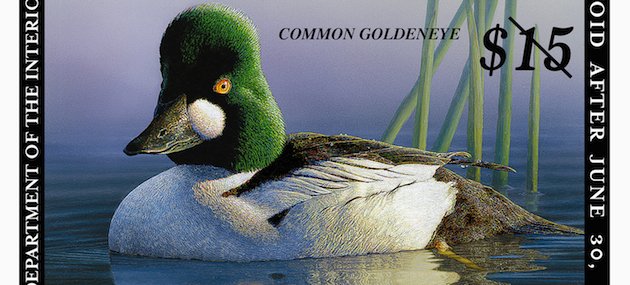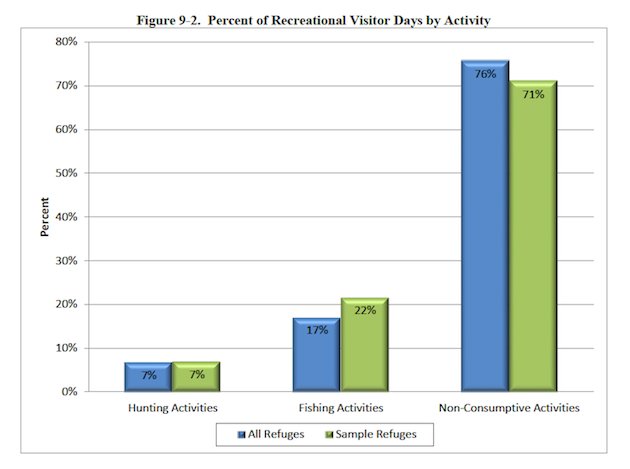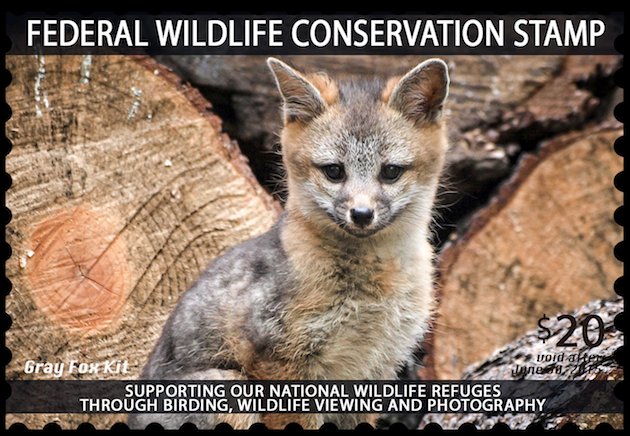
The National Wildlife Refuge system is one of America’s greatest treasures. It preserves habitat, protects wildlife. and provides diverse nature experiences for visitors from around the world.
According to the latest (2013) report by the U.S. Fish & Wildlife Service (USFWS) entitled “BANKING ON NATURE: The Economic Benefits to Local Communities of National Wildlife Refuge Visitation1,” recreational visits to national wildlife refuges generate substantial economic activity.
In Fiscal Year 2011:
- 46.5 million people visited refuges. Their spending generated $2.4 billion of sales in regional economies. As this spending flowed through the economy, over 35,000 people were employed and $792.7 million in employment income was generated.
- ABOUT 72 PERCENT OF TOTAL EXPENDITURES ARE GENERATED BY NON-CONSUMPTIVE ACTIVITIES ON REFUGES. Fishing accounted for 21 percent and hunting 7 percent. Local residents accounted for 23 percent of expenditures while visitors coming from outside the local area accounted for 77 percent.
- Refuge recreational spending generated about $342.9 million in tax revenue at the local, county, state and Federal level.
Coinciding with these figures is something we have suspected for a long time, the majority of Recreational Visitor Days are attributable to non-consumptive activities, followed by fishing activities and hunting activities.
Due to some erroneous numbers thrown about by Duck Stamp advocates, I feel that some explanations are in order.
Funds for National Wildlife Refuge land acquisition come from several sources. Congress appropriates these monies primarily with funding from the Land and Water Conservation Fund (LWCF) and the Migratory Bird Conservation Fund (MBCF).
The LWCF receives money from: (1) tax on motorboat fuels, (2) sale of surplus Federal real property, and 3) Outer Continental Shelf oil and gas leasing fees.
The MBCF receives money from: (1) sale of Duck Stamps, (2) import duties on firearms and ammunition (not excise taxes which are paid to the states for wildlife and habitat management), (3) appropriations from the General Fund, (4) right-of-way permit and/or easement fees and the sale of surplus refuge lands, (5) any monies remaining after refuge revenue sharing payments have been made to the counties each Fiscal Year, and (6) any Federal Aid monies that are unexpended by a state each Fiscal Year. Collectively, these MBCF funds have purchased about 2.7 million acres or about 3% of refuge land2. To be clear, Duck Stamp proceeds make up only a portion of the 3% of refuge land purchased by the MBCF.
Now, as the popularity of hunting has declined, so too have the sales of Duck Stamps. In 1972 the greatest number of stamps were sold at over 2.4 million. In 2011 that number has decreased to 1.5 million, a 37% reduction3.
Because of these declines, there has been a recent push to encourage birders and other non-consumptive users to buy the Duck Stamp; however, these programs face some understandable resistance. They don’t take into account the valid concerns non-hunters have about buying the stamp, which fall into two main areas:
1. Many wildlife watchers, birders and photographers don’t want to support a stamp that is so intimately and historically associated with hunting.
2. Duck Stamp sales to non-hunters are not accurately calculated to reflect their contributions – which tends to short change the conservation goals of non-consumptive users.
Case in point. On March 5, 2014, the U.S. Fish and Wildlife Service Director Dan Ashe announced the agency will expand hunting and fishing opportunities throughout the National Wildlife Refuge System, opening up new hunting programs on six refuges and expanding existing hunting and fishing programs on another 20 refuges. The rule also modifies existing refuge-specific regulations for more than 75 additional refuges and wetland management districts4.
Is it just me, or does this make no sense?
With all the talk about loss of revenue from the dwindling number of waterfowl hunters, you would think that the U.S. Fish & Wildlife Service would be ecstatic about the growing number of wildlife watchers and non-consumptive users of the National Wildlife Refuges. You would think they would look at these numbers and try to figure out a way to tap into that huge demographic right?
They haven’t, but we have. We have a very simple solution.
Create a second fund-raising stamp for wildlife watchers. A new stamp that says to all non-consumptive users, “You matter, your choices matter, your conservation priorities matter.”
A new stamp that establishes an unambiguous revenue stream for our National Wildlife Refuges while resonating with the values and ethics of the non-hunting community.
A Wildlife Conservation Stamp!
Is this idea so difficult to grasp? From the comments we have received over the last year there are thousands of birders, wildlife photographers and others that think this is a great solution to a simple problem. Create a more appealing alternative for non-consumptive users of our refuge system and give people a choice.
There is no competition here. Simply an alternative. An additional choice. One that would obviously be the only choice for some conservationists who want to directly support our National Wildlife Refuge System.
I have yet to hear one substantial argument opposing this proposal. There is just no downside to offering the overwhelming majority of refuge visitors an additional choice. It’s a no-brainer.
Support creation of a Wildlife Conservation Stamp. If you are an individual wanting to support this proposal, check out our “About Us” page and fill out the submission form at the bottom of the page. If you are an organization wanting to add your support, check out our “Organizations In Support” page and fill out the form at the bottom of that page. You can also show your support by liking our Facebook page and following us on Twitter!
References: 1US Fish & Wildlife Service, 2US Fish & Wildlife Service, 3US Fish & Wildlife Service, 4US Fish & Wildlife Service













those stamps are fantastic revenue earners for a great cause and such brilliant photography
It’s time to let go off notions that hunting is the only means to sustain wildlife habitats. It not only sets the wrong example for our children but it continues to encourage the notion that “shooting ducks” is okay, when we all know very well there are people who would rather not promote funding for our national refuges this way. The Duck Stamp promotes adult’s endeavours, such as hunting, in which children and other nature observers do not wish to participate in. It’s time to promote funding for our wildlife refuges in a different way, one that will promote respect for all living creatures alike.
The Migratory Bird Conservation Stamp (Bird Stamp) infrastructure is in place. Congress is not willing to make any move on any additional stamps at this time. If we as birders show our support now and every year for the already in place Migratory Bird Conservation Stamp we will be supporting the 700 species of birds, 220 species of mammals, 250 reptile and amphibian species and more than 1000 species of fish. Endangered species are a priority of National Wildlife Refuges in that nearly 60 refuges have been established with the primary purpose of conserving 280 threatened or endangered species.
It is time we stood up NOW…TODAY…and purchase a Migratory Bird Conservation Stamp…EVERY YEAR using this fantastic opportunity to support all wildlife and birds along with clean water air habitat. We have this remarkable opportunity at our fingertips. This legislation was created for us…all of us…all Americans. It was never created for only one demography of a special interest. The difference is a hunter HAS to purchase a Bird Stamp while birders through their intelligence understanding , and compassion volunteer to buy these refuges. Our sincere LOVE of birds and wildlife makes us willing partners. We must pledge this each year and show our support to this legislation laid at our feet now. In time and with the show of our immense support we will THEN be able to expand this incredible legislation if need be. Until we show our dollars and cents support there will not be legislation passed.
The way to be counted as a BIRDER when you purchase a Migratory Bird Conservation Stamp is to purchase through the American Birding Association aba.org. They are counting us and keeping track of our support. The Federal Migratory Bird Conservation Stamp Office is considering putting a database in place to count us accurately. The Revised North American Waterfowl Management Plan has finally just recognized the huge support of Birders. But we have to wake up and show our support by purchasing a Migratory Bird Conservation Stamp. This is a BIRD STAMP! Super important opportunity
Actually, the duck stamp was made specifically for duck hunters.
The Migratory Bird Conservation Stamp was created to fund the Migratory Bird Conservation Act of 1929. (Norbeck-Anderson Act) This Act established the Migratory Bird Conservation Commission to approve areas recommended by the Secretary of the Interior. The problem was their was no funding for this. The history is fascinating.
Birders Started the Refuge system in 1903. Birders have been instrumental and present through all legislation for Migratory Birds. The Migratory Bird Treaty Act, The Migratory Bird Conservation Act. The Migratory Bird Hunting and Conservation Act. NOTE The word Conservation. That is our word to stand up once again on behalf of ALL MIGRATORY BIRDS.
We must not give up we must do what we have done for over a century…Stand up and help the birds we love. The easiest way is to annually purchase a migratory Bird Stamp. Possibly once we hav shown we truly are serious about supporting the Conservation of Migratory Birds with our pledged donations the effort to produce a Wildlife stamp has a chance. It has been proven that the birders of today spend Billions of dollars in goods and services but they will not devote money voluntarily to dedicated funding to purchase on the ground habitat.
I have been as frustrated as many of you because of the back seat birders have been forced to take. Our huge numbers supporting our National Wildlife System and the Birds we love through pledging an annual Bird Stamp would no doubt raise attention.
I am a hunter, birder, wildlife watcher and naturalist. I have long thought your idea was a great one. I also support hunting on national wildlife refuges and don’t see expanding hunting opportunities as inconsistent with this stamp idea.
Sometimes I think hunting groups have harpooned alternate stamp ideas (and alternate funding sources for state game agencies, too) because they fear this will diminish their clout. As a hunter, I find that unfortunate. We need all the support for wildlife habitat we can get.
In fairness, however, “non-consumptive users” have in the past sometimes been lukewarm of support of such stamp programs. I would love to be proven wrong.
It is time for a Wildlife Conservation Stamp, and also time for birders and others to buy one. I’ll buy both — my Duck Stamp and my Wildlife Conservation Stamp.
I